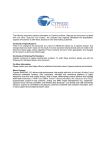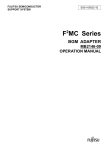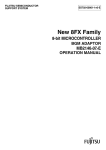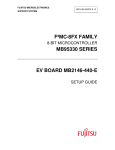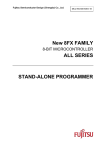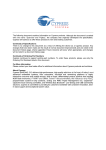Download Manual
Transcript
The following document contains information on Cypress products. FUJITSU SEMICONDUCTOR SUPPORT SYSTEM SS01-00022-2E F2MC Series BGM ADAPTER MB2146-09 OPERATION MANUAL PREFACE Thank you for purchasing the F2MC * series BGM adapter (model number MB2146-09). The product is a development support tool for developing and evaluating applied products which use Fujitsu microcontrollers (hereafter MCUs) incorporating BDSU modules. This manual describes how to handle the F2MC series BGM adapter. Be sure to read it before using the product. For information on the MCUs supported by this product, contact the Fujitsu sales or support representative. * : F2MC is the abbreviation used for FUJITSU Flexible MICRO CONTROLLER. ■■ For Your Safety This manual contains important information required for using the product safely. Be sure to read through the manual before using the product and follow the instructions contained therein to use it correctly. In particular, carefully read "Caution of the products described in this manual" at the beginning of this manual to understand the requirements for safe use of the product before using it. After reading the manual, keep it handy for future reference. ■■ Warranty and Liability The specifications of the product are subject to change without notice. Fujitsu assumes no liability for any loss or damage whatsoever directly or indirectly arising out of the use of the product. ■■ Related Manuals You should refer to the following manuals as well: • “HARDWARE MANUAL” for each type of microcontroller • “DATA SHEET” for each type of microcontroller • “SOFTUNE Workbench OPERATION MANUAL” • “SOFTUNE Workbench USER’S MANUAL” • “SOFTUNE Workbench COMMAND REFERENCE MANUAL” ■■ Caution of the products described in this document The following precautions apply to the product described in this manual. WARNING Indicates a potentially hazardous situation which, if not avoided appropriately, could result in death or serious injury and/or a fault in the user’s system. Electric shock, Damage Before performing any operation described in this manual, turn off all the power supplies to the system. Performing such an operation with the power on may cause an electric shock or device fault. Electric shock, Damage Once the product has been turned on, do not touch any metal part of it. Doing so may cause an electric shock or device fault. iii CAUTION Indicates a potentially hazardous situation which, if not avoided appropriately, may result in minor or moderate injury and/or damage to the product or the equipment to which the product is connected, to software resources such as data, or to other properties. Cuts, Damage Before moving the product, be sure to turn off all the power supplies and unplug the cables. Watch your steps when carrying the product. Do not use the product at an unstable location such as a place exposed to strong vibration or a sloping surface. Doing so may let the product fall, resulting in an injury or fault. Damage Neither put anything on or apply shock to the product. Once the product has been powered, do not carry it. Doing either may cause a fault due to a load or shock. Damage Since the product contains many electronic components, keep it away from direct sunlight, high temperature, and high humidity to prevent condensation. Do not use or store the product where it is exposed to much dust or a strong magnetic or electric field for an extended period of time. An adverse operating or storage environment can cause a fault. Damage Use the product within the ranges of its general specifications. Please look at “4. Specifications” about the use range. Operating it outside the range of any general specification may cause a fault. Damage To prevent electrostatic breakdown, do not let your finger or an object touch any metal part of the connector. Before handling the product, touch a metal object (such as a door knob) to discharge static electricity from your body. Damage When turning the power on or off, follow the relevant procedure described in this document. Before turning the power on, in particular, be sure to finish making all the required connections. To set up and use the product, follow the instructions given in this document. Using the product incorrectly or inappropriately may cause a fault. Damage Before plugging or unplugging any cable for this product, be sure to turn the power supply off. When unplugging the cable, remove it while holding the connector without pulling the cable itself. Pulling the cable itself or bending it may expose or disconnect the cable core, resulting in a fault. Damage When stored, the product should be kept in its packaging box as it has no housing. Re-transporting the product may damage it to cause a fault. Keep the packaging materials used for shipment of the product and use them when re-transporting it. iii • The contents of this document are subject to change without notice. Customers are advised to consult with FUJITSU sales representatives before ordering. • The information, such as descriptions of function and application circuit examples, in this document are presented solely for the purpose of reference to show examples of operations and uses of FUJITSU semiconductor device; FUJITSU does not warrant proper operation of the device with respect to use based on such information. When you develop equipment incorporating the device based on such information, you must assume any responsibility arising out of such use of the information. FUJITSU assumes no liability for any damages whatsoever arising out of the use of the information. • Any information in this document, including descriptions of function and schematic diagrams, shall not be construed as license of the use or exercise of any intellectual property right, such as patent right or copyright, or any other right of FUJITSU or any third party or does FUJITSU warrant non-infringement of any third-party’s intellectual property right or other right by using such information. FUJITSU assumes no liability for any infringement of the intellectual property rights or other rights of third parties which would result from the use of information contained herein. • The products described in this document are designed, developed and manufactured as contemplated for general use, including without limitation, ordinary industrial use, general office use, personal use, and household use, but are not designed, developed and manufactured as contemplated (1) for use accompanying fatal risks or dangers that, unless extremely high safety is secured, could have a serious effect to the public, and could lead directly to death, personal injury, severe physical damage or other loss (i.e., nuclear reaction control in nuclear facility, aircraft flight control, air traffic control, mass transport control, medical life support system, missile launch control in weapon system), or (2) for use requiring extremely high reliability (i.e., submersible repeater and artificial satellite). Please note that FUJITSU will not be liable against you and/or any third party for any claims or damages arising in connection with above-mentioned uses of the products. • Any semiconductor devices have an inherent chance of failure. You must protect against injury, damage or loss from such failures by incorporating safety design measures into your facility and equipment such as redundancy, fire protection, and prevention of over-current levels and other abnormal operating conditions. • If any products described in this document represent goods or technologies subject to certain restrictions on export under the Foreign Exchange and Foreign Trade Law of Japan, the prior authorization by Japanese government will be required for export of those products from Japan. ©2005 FUJITSU LIMITED Printed in Japan ivi 1. Checking the Delivered Product Before using the product, make sure that your package contains the following items: • • • • BGM adapter * USB cable (2.0 m) Operation manual (Japanese version)) Operation manual (English version - This document) :1 :1 :1 :1 * : Hereafter called the adapter. 2. Appearance and Part Names Figures 1 and 2 show the adapter appearance, major dimensions and part names. POWER LED User interface connector USB connector Interface cable 100 mm 100 mm Figure 1 Adapter Appearance (Top view) 25 mm USB connector 40 mm Figure 2 Adapter Appearance (Front view) 1 3. Connecting the Adapter ■ System Configuration (emulator system) Connect the adapter between the host machine and the user system so that the adapter can serve as an emulator under control of the host machine. For using emulator debugger software on the host machine, refer to the "SOFTUNE Workbench OPERATION MANUAL". Figure 3 shows the system configuration. Host machine *1 Adapter *2 User interface connector Adapter interface connector MCU User system *1 : USB cable *2 : Interface cable (adapter’s flat cable) Figure 3 System Configuration (emulator system) ■ System Configuration (USB programmer) The adapter connects the host machine and the serial interface of MCU with built-in flash memory made by Fujitsu, and writes data in a built-in flash memory. For information on the USB programmer, contact the Fujitsu sales or support representative. Figure 4 shows the system configuration. Host machine *1 Adapter *2 User interface connector Adapter interface connector MCU with built-in flash memory made by Fujitsu User system *1 : USB cable *2 : Interface cable (adapter’s flat cable) Figure 4 System Configuration (USB programmer) 2 ■ Connection to the Host Machine Connect the adapter to the host machine using the USB cable. Figure 5 shows how to plug the USB cable. Connection to the USB connector of the adapter Adapter Figure 5 Plugging the USB Cable ■ Connection to the User System Connect the adapter to the user system. Plug the user interface connector of the adapter into the adapter interface connector on the user system. When plugging the user interface connector, align its index mark (pin No. 1) with the adapter interface connector’s counterpart. For the specifications of the adapter interface connector, see "Adapter Interface Specifications" in Section 4 "Specifications". Figure 6 shows how to connect the adapter to the user system. Adapter interface connector on the user system User interface connector Index mark (pin No. 1) Adapter User system Figure 6 Connecting to the User System 3 4. Specifications ■ General Specifications Table 1 lists the general specifications of the adapter. Table 1 General Specifications Item Specification Name F2MC series BGM adapter Model number MB2146-09 Adapter power input Max 50 mA (USB BUS power used) User power input +2.7 V to +5.5 V *1 Max 20 mA *2 Power supply specifications POWER LED indication [Green]: On when only adapter power is supplied (with the USB cable connected). [Red]: On when only user power is supplied. [Orange]: On when both adapter power and user power are supplied. User interface connector *3 MIL standard compliant key type (with the center key) Operating temperature/humidity +5 to +35 °C 20 to 80 % (No condensation allowed) Storage temperature/humidity 0 to +70 °C 20 to 80 % (No condensation allowed) Adapter case : 40 (W) × 100 (D) × 25 (H) mm (Protrusions excluded) Dimensions Interface cable length: 100 mm (User interface connector excluded) Weight 55 g *1 : The maximum and minimum voltages depends on the MCU used. For details, contact the Fujitsu sales or support representative. *2 : The power consumption by the MCU used is not included. *3 : The connector part number is given below. FAS-1001-2101-0BF (YAMAICHI ELECTRONICS Co., Ltd.) ■ USB Line Specifications Table 2 lists the USB line specifications of the adapter. Table 2 USB Line Specifications Item 4 Description Conforming standard USB1.1 Communication method Full Speed Bulk Transfer Data transfer rate 12Mbps Connector shape Series B Power supply BUS Powered ■ Tool Reset Specifications A tool reset is a hardware reset by the adapter to reset the entire system of the MCU (including the BDSU module) on the user system. When both of the adapter power and MCU’s user power are turned on, the tool reset is canceled automatically to enable the MCU to be evaluated. The following shows how to generate a tool reset and how long it remains in effect. • Tool reset generation methods and reset "L" pulse width 1) Set the MCU user power from OFF to ON (power-on reset). The reset remains in effect for about 16 to 70 ms after the MCU user power is supplied. 2) Set the adapter power from OFF to ON (by unplugging and plugging the USB cable). The reset remain in effect for about 32 to 140 ms after the adapter power is supplied. If the user system and adapter cause an uncontrollable error but the system cannot be recovered by tool reset generation method 1), execute tool reset generation method 2). 5 ■ Adapter Interface Specifications Table 3 is a pinout of the adapter interface connector mounted on the user system. Table 5 lists recommended connectors. Figure 7 shows the connector pins. When the adapter interface connector is installed on the user system, connect the adapter interface connector to the MCU according to the following specifications. Table 3 Adapter Interface Connector Pinout (emulator system) Connector pin No. Input / output * Evaluation MCU connection terminal 1 BGMA <- MCU UVCC 2 GND 3 BGMA -> MCU TRESETX 4 BGMA -> MCU 5 Function Remarks User power supply input Connected to the MCU’s Vcc pin. Vss Connected to the MCU’s Vss pin. Tool reset output BDSU, Initialization of user’s logic DMDX Mode change output 0 : Debug mode 1 : Free run mode BGMA <- MCU SOUT Serial data input SD for UART 6 BGMA <- MCU EXC External clock input Base clock for UART 7 BGMA -> MCU SIN Serial data output RD for UART 8 N.C Not used Not connected 9 GND Vss Connected to the MCU’s Vss pin. 10 BGMA <- MCU UVCC User power supply input Connected to the MCU’s Vcc pin. * : "BGMA" and "MCU" in the "Input/output" column in the table indicates the "BGM adapter" and "Evaluation MCU" respectively. Table 4 Adapter Interface Connector Pinout (USB programmer) Connector pin No. Input / output *1 Evaluation MCU connection terminal Function 1 BGMA <- MCU UVCC User power supply input Connected to the MCU’s Vcc pin. 2 GND Vss Connected to the MCU’s Vss pin. 3 BGMA -> MCU RSTX Tool reset output BDSU, Initialization of user’s logic 4 N.C Mode change output Not used. Not connected. 5 BGMA <- MCU UOx *2 Serial data input SD for UART 6 BGMA -> MCU UCKx *2 7 BGMA -> MCU UIx *2 8 9 10 Remarks Synchronous clock output Base clock for UART Serial data output RD for UART N.C Not used Not connected GND Vss Connected to the MCU’s Vss pin. BGMA <- MCU UVCC User power supply input Connected to the MCU’s Vcc pin. *1 : "BGMA" and "MCU" in the "Input/output" column in the table indicates the "BGM adapter" and "Evaluation MCU" respectively. *2 : Please refer to each MCU specifications for the serial port number that corresponds to the serial interface for the USB programmer. 6 Table 5 Recommended Adapter Interface Connectors Part number Specifications Manufacturer FAP-1001-2202-0BS Right-angle solder dip Housing providedMiddle latch provided FAP-10-08#2-0BS Housing providedMiddle latch provided YAMAICHI ELECTRONICS Right-angle solder dip Housing providedLatch not provided Co., Ltd. FAP-10-08#4-0BS Straight solder dip FAP-1001-2204-0BS Straight solder dip Housing providedLatch not provided Index mark 9pin 1pin 10pin 2pin (TOP VIEW) Figure 7 Adapter Interface Connector Pins ■ Options Various options are available to the adapter. Purchase them as required. See Table 6 for the options. Table 6 Options Name MCU * Part number MBxxxxx * : The part number depends on the MCU used. For details, contact the Fujitsu sales or support representative. 7 SS01-00022-2E FUJITSU SEMICONDUCTOR • SUPPORT SYSTEM F2MC Series BGM ADAPTER MB2146-09 OPERATION MANUAL February 2005 the second edition Published FUJITSU LIMITED Electronic Devices Edited Business Promotion Dept.


















